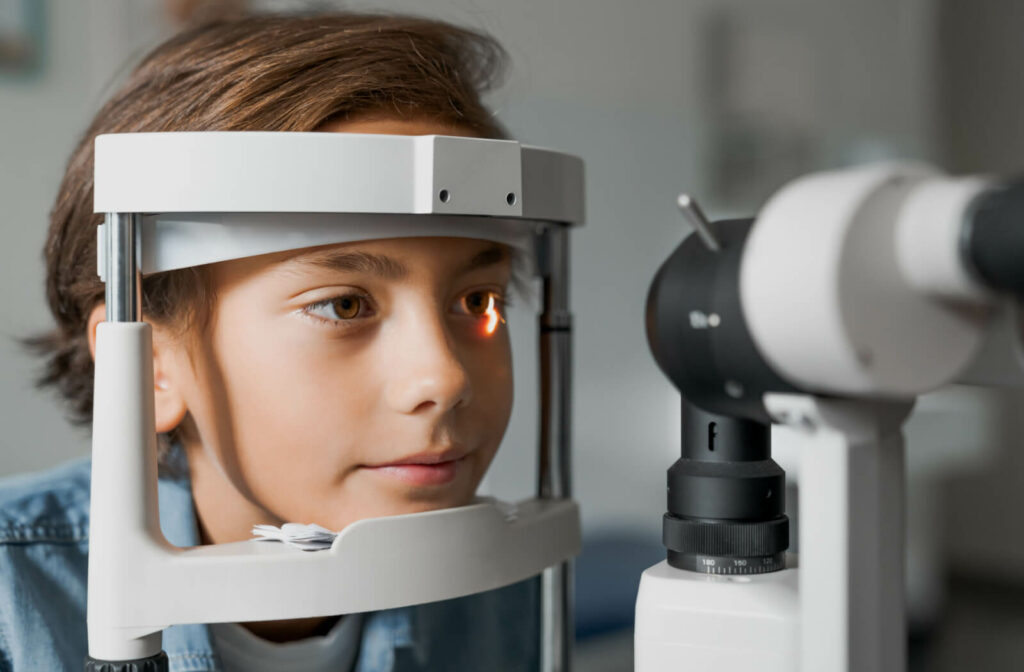Your child’s vision is important, but that doesn’t mean it’ll always be perfect. You may have heard of nearsightedness and farsightedness, but there’s one more common refractive error: astigmatism. This condition occurs when the cornea itself is misshapen and, when left untreated, causes blurry vision and eye strain.
Over time, astigmatism can lead to headaches, light sensitivity, and difficulty seeing at all distances. Fortunately, you can visit your optometrist for a pediatric eye exam and discuss treatment options like eyeglasses, contacts, and even the potential of laser surgery once their eyes are done developing.
What Is Astigmatism?
Astigmatism is a common type of refractive error, which prevents light from focusing properly on the retina. When your cornea—the clear front part of your eye—is shaped properly, it bends light to focus on the retina and create a clear image.
But what if the cornea isn’t shaped properly? This is astigmatism. Instead of being perfectly round like a basketball, eyes with astigmatism are shaped more like a football. This shape scatters the light, preventing it from focusing properly on the retina.
Since astigmatism causes blurry and distorted vision at all distances, it can make everyday life difficult. There are 2 main types of astigmatism:
- Regular, where the football-like curve is a universal bend
- Irregular, where the curve is bumpier and isn’t universal
Astigmatism can begin at any age, including early childhood. Some people are born with astigmatism, while others develop it over time. This is why children’s eye exams are so important—early detection allows an optometrist design a treatment plan for your child to minimize the effects of astigmatism.
What Causes Children to Develop Astigmatism?
Like most refractive errors, astigmatism often begins to develop early in life. Factors that contribute to this development often include:
- Genetics
- Eye injury
- Certain diseases, such as keratoconus, that can cause the cornea to thin and become more cone-shaped
- Environmental factors, like living in a poorly lit environment or exposure to pollutants or chemicals
- Eye strain and constant eye rubbing
- Poor nutrition
Signs That a Child Has Astigmatism
If you’re worried your child may be developing astigmatism, there are some symptoms to look for. Keep in mind, the eye is an incredibly complex organ, and many of these symptoms can be an indicator of several different eye conditions. It’s always recommended to visit an optometrist if you’re worried about your child’s vision. But you can still keep an eye out for these signs:
- They’re having difficulty reading or seeing objects both up close and at a distance
- They frequently squint or close 1 eye to see better
- They complain about headaches or eye strain
- They’re having trouble focusing on schoolwork
- They mention that things are looking blurry or distorted
- They are overly sensitive to light
Any of these could be an indication your child is beginning to develop a vision problem like astigmatism.
How Is Astigmatism Treated?
Astigmatism can’t be cured in a way that makes it permanently go away on its own. But there’s good news: Astigmatism is highly treatable. These methods help correct the refractive error and aim to give your child clear vision.
Eyeglasses or contact lenses are typically the first recommended options. They’re designed to counteract the irregular shape of the cornea and bend light to properly focus on the retina.
For some, refractive surgery may even be an option. This surgery changes the shape of the cornea to allow light to focus properly on the retina. However, this isn’t usually recommended until your child’s eyes have fully developed, as they may continue changing shape as your child grows.
Remember: Vision can play a significant role in how children learn, grown, and interact with the world. Most of your child’s learning is vision-based, so it’s essential to regularly schedule pediactric eye exams to keep their vision clear and strong.

What to Do if Your Child Has Astigmatism
If you’ve noticed any symptoms of astigmatism in your child, come see us at Fort Myers Eye Associates. We can perform a comprehensive eye exam and help build a treatment plan for your child. Early detection and treatment are key to keeping your child’s vision strong, so book an appointment with us today.





